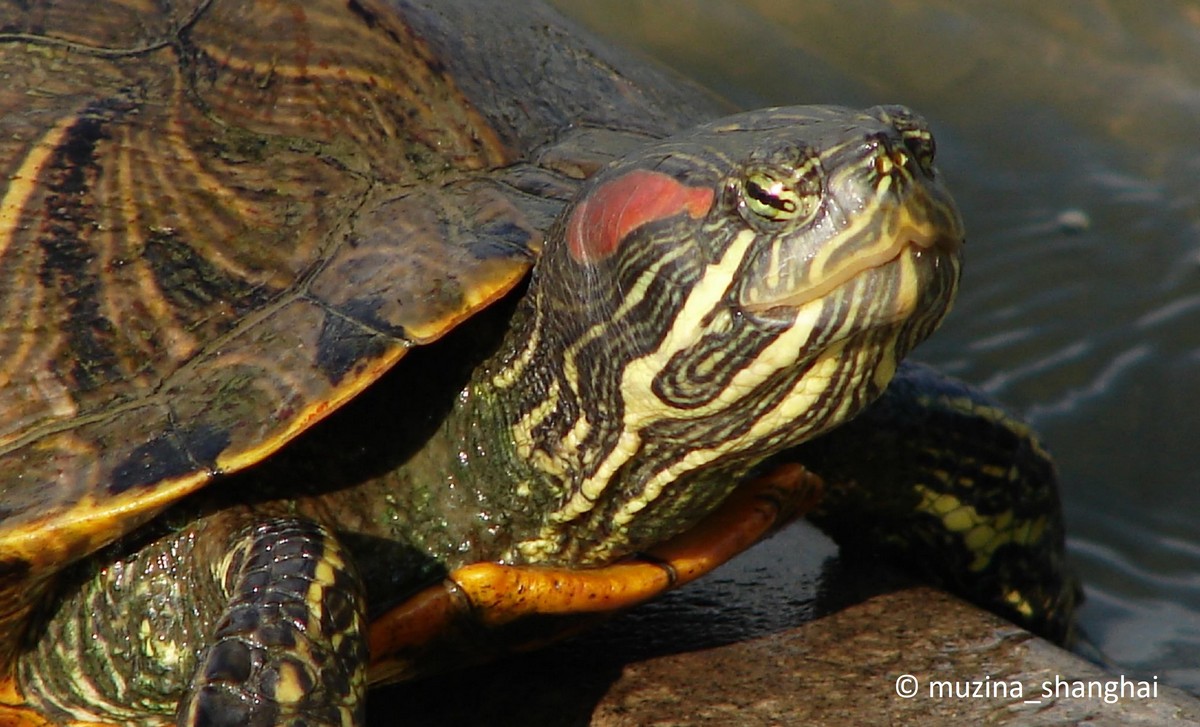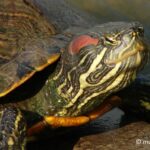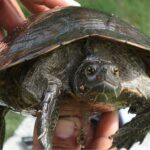
- Common name: Yellow-bellied slider turtle, Pondslider, Pond slider
- Scientific name : Trachemys scripta (Schoepff, 1792)
- Local name: Tortue de Floride
- Order : Testunides
- Family : Emydidae

Source : Vamberger et al., (2020)
Description
Morphology. Medium sized freshwater turtle, Trachemys scripta is characterised by an elliptical carapace, moderately domed and serrated on the posterior part. The carapace varies from brown, olive green to black, with different yellow-orange patterns on the pleural scutes (Vamberger, 2020). The plastron is relatively large and without hinge, with a posterior notch. The plastron of young individuals is pale yellow to light orange, with a variety of dark markings in different subspecies (Seidel, 2002; Seidel and Ernst, 2012).
T. scripta is distinguished from other Trachemys species by the presence of a yellow and/or red postorbital stripe accompanied by several yellow stripes on the head (Jacob and Kinet, 2007; Vamberger, 2020).
The neck and limbs of juvenile individuals often show yellow and black stripes or wavy marks. Old males frequently develop melanism resulting in the loss of these characteristic marks (Seidel, 1988; Seidel, 2002).
Standard body size (carapace length). males: 110 to 240 mm; females: 120 to 290 mm (Gibbons and Lovich 1990, Gradela et al. 2017).
Plastron length: 90 to 168 mm in males; 150 to 264 mm in females (Taniguchi et al. 2017).
Sexual dimorphism. Females are generally larger and heavier than males (Parker, 1996).
Male Trachemys have elongated tails and a cloaca extending from the posterior part of the carapace, while females have a shorter tail and a cloaca that does not extend beyond the posterior part of the carapace (Seidel and Ernst 2012, Gradela et al. 2017).
Variations. Three subspecies have been identified: T. s. scripta, T. s. elegans, T. s. troosti. The last two would be distinguished from the first by the presence of a postorbital stripe, red in colour in T. s. elegans, and yellow in T. s. troosti (Ernst and Jett, 1969). However, recent data suggest that the differences observed stem more from differentiation between populations rather than from true taxonomic differentiation (Vamberger et al. 2020).
Possible confusion with other species. Confusion is possible with several species of the genus Trachemys formerly considered as subspecies: T. ornata, T. gaigeae, T. grayi, T. dorbigini, T. adiutrix. The specific status of these species has been determined on the basis of differences in courtship behaviour and reproductive isolation observed in captivity (Jackson and Davis, 1972; Seidel and Fritz, 1997; Seidel, 2002). However, no exhaustive phylogenetic study of continental forms of Trachemys has been conducted (Seidel, 2002).
Distribution
Native. United States and Mexico.
Introduced. America: Canada, United States (Guam, Hawai, Mariana islands), Guatemala, Belize, Honduras, Salvador, Nicaragua, Costa Rica, Colombia, Guyana, Surinam, Chile, Brazil, Argentina (Ramsay et al., 2007; Maillard and David, 2014).
Europe: Irlande, Great Britain, France (continental, Réunion, Polynésie), Portugal, Spain, Sueden, Danemark, Netherlands, Belgium, Germany, Switzerland, Italia, Czech Republic, Slovakia, Austria, Poland, Hungaria, Slovenia, Greece, Cyprus, Romania, Bulgaria, Turkey, Russia (Ramsay et al., 2007; Maillard and David, 2014).
Africa: Gambia, Egypt, South Africa, Sri Lanka, Seychelles (Ramsay et al., 2007; Maillard and David, 2014).
Asia: Israel, Saudi Arabia, Bahrein, Iran, Myanmar, Thailand, Cambodia, Vietnam, Hong Kong, Taiwan (Lee et al., 2019), Japan, Malaysia, Singapore, Indonesia, Philippines, South Korea (Ramsay et al., 2007; Maillard and David, 2014).
Oceania: Australia, Palau, New Zealand, Micronesia (Ramsay et al., 2007; Maillard and David, 2014).
Caribbean: Bermuda, Cayman islands, Dominican Republic, Porto Rico, US and British Virgin Islands, Saint Martin, Guadeloupe, Martinique (Ramsay et al., 2007; Maillard and David, 2014).
Biology and ecology
Habitat. As demonstrated by its global distribution, Trachemys scripta is able to cope with a great variety of climat conditions and habitats. The species appears more abundant in shallow, soft-bottomed water bodies with minimal flow, good access to sunlight, and extensive vegetation. However, in Mexico, the species appears to be more abundant in riverine habitats. In Europe, T. scripta is also observed near human dwellings and recreation centres (Van Dijk, 2011; Thomas, 2006; Ernst and Lovich, 2009).
Diet. Omnivore, with variations according to the ontogenetic stage. The diet of juveniles is mainly composed of insects, spiders, snails and tadpoles with a small amount of macrophytes and macro-algae (Newbery, 1984; Arasco et al., 2015). Adults consume fewer insects, but more macro-algae, macrophytes, amphibians and fish, as well as waterbird chicks (Newbery 1984; Parmenter and Avery 1990; Jacob and Kinet, 2007; Ramsay et al. al., 2007; Arasco et al., 2015).
Reproduction. The nesting season happen from late April to mid-July (Cagle, 1950). Females produce up to three clutches, of 5 to 20 eggs, per year. Incubation lasts 60 to 91 days (Gibbons, 1990; Thomas 2006; Ernst and Lovich 2009).
Impact and management of introduced populations
Impact. In regions where the species has been introduced, the presence of T. scripta can result in significant competitive pressure on autochthonous populations of freshwater turtles that share equivalent ecological niches. It has been shown that the presence of T. scripta led to a reduction in sunbathing time in the European species Emys orbicularis (Cadi and Joly, 2003) and in the Leprous Emyde Mauremys leprosa, native to Spain and the Maghreb (Polo-Cavia et al., 2010a). This degradation of sunbathing activity can have negative repercussions on the thermoregulation of individuals, and thus affect physiological functions such as digestion or locomotion.
Polo-Cavia and colleagues (2009) have also demonstrated in M. leprosa an avoidance behaviour of water ponds in which the chemical signals of T. scripta were detected.
T. scripta could also generate significant competitive pressure for access to resources. The species has been shown to be more aggressive and dominant during interactions with M. leprosa, allowing it to take up more food resources than the latter (Polo-Cavia et al., 2011).
Polo-Cavia and colleagues (2010b) studied the recognition of chemical signals of T. scripta and M. leprosa in tadpoles of different anuran species from the Iberian Peninsula. This work highlights the poor recognition of chemical signals of the exotic species compared to those of the native species. This naiveté of anuran species for an exotic predator can have important consequences in terms of predation pressure for these prey species, and competition for M. leprosa (Polo-Cavia et al., 2010b).
T. scripta can also have a significant impact on aquatic invertebrates, particularly in ecosystems where there is no native analogue species (Cuthbert et al. 2019).
Management. T. scripta as an invasive species is prohibited from introduction into several European countries by Regulation (CE) No. 338/97 of the European Council (Conseil Européen, 1997) and Regulation No. 1143/2014 of the European Union (Parlement Européen, 2014). Globally, CITES establishes several restrictions on the import of the species (CITES, 2011).
In Australia and New Zealand, plans to manage and reduce the presence of T. scripta are also conducted (O’Keeffe, 2006).
Bibliography
- Aresco, M. J., Travis, J., & MacRae, P. S. D. (2015). Trophic interactions of turtles in a North Florida lake food web: prevalence of omnivory. Copeia, 103, 343–356.
- Arvy C. & Servan J. (1998). Imminent competition between Trachemys scripta and Emys orbicularis in France. In: Proceedings of the Emys Symposium (U. Fritz, U. Joger, R. Podloucky & J. Servan, editors), Dresden, 1996, Mertensiella (Supplement zu Salamandra), 10: 33-40.
- Cadi, A., & Joly, P. (2003). Competition for basking places between the endangered European pond turtle (Emys orbicularis galloitalica) and the introduced red-Eared slider (Trachemys scripta elegans). Canadian Journal of Zoology, 81, 1392–1398.
- Cagle, F. R. (1950). The life history of the Slider Turtle, Pseudemys scripta troostii (Holbrook). Ecological Monographs, 20, 31–54.
- CITES, 2011. Conservation et commerce des tortues d’eau douce et des tortues terrestres, 38.
- Conseil de l’Union Européenne, 1997. Règlement (CE) nº 338/97 du Conseil du 9 décembre 1996 relatif à la protection des espèces de faune et de flore sauvages par le contrôle de leur commerce, 69.
- Cuthbert, R.N., Coughlan, N.E., Dickey, J.W.E., Rea, M., Laverty, C., South, J., Crane, K., McCard, M. & Dick, J.T.A. (2019). Shell shocked: high potential impacts on native prey by non-native turtles irrespective of benthic habitat context. Aquatic Invasions 14, 758-774.
- Dubief, O. (2018). Gestion et évaluation d’ une espèce exotique envahissante en milieu urbain: le cas des tortues d’ eau douce de l’ Eurométropole.
- Ernst, C. H. & Jett, B. G. (1969). An Intergrade Population of Pseudemys scripta elegans x Pseudemys scripta troosti in Kentucky. Journal of Herpetology 3, 103.
- Ernst, C.H., & Lovich, J.E. (2009). Turtles of the United States and Canada. Second edition. Johns Hopkins University Press, Baltimore.
- Gibbons J.W. (1990). The slider turtle. Life history and ecology of the slider turtle. Smithonian Institution Press, Washington, DC, USA, 396.
- Gibbons J.W. & Lovich, J.E. (2009). Sexual dimorphism in turtles with emphasis on the Slider Turtle (Trachemys scripta). Herpetological Monographs 4, 1-29.
- Gradela, A. et al. (2017). Sexual Dimorphism in Red-Eared Sliders (Trachemys scripta elegans) from the Wild Animal Triage Center of the Tiete Ecological Park, São Paulo, Brazil. Acta Scientiae Veterinariae 45, 1468.
- Jackson, C. G., & Davis, J. D. (1972). A quantitative study of the courtship display of the Red-Eared Turtle, Chrysemys scripta elegans (Wied). Herpetologica, 28, 58–64.
- Jacob, J., & Kinet, T. (2014). La « Tortue de Floride » Trachemys scripta (Schoepf, 1792). In J. J.-P, P. C., de W. H., G. E., K. T., D. M., … R. A. (Eds.), Amphibiens et Reptiles de Wallonie. Aves-Raînne & Centre de Recherche de la Nature, de la Forêt et du Bois (MRW-DGRNE).
- Lee, K. H., Chen, T. H., Shang, G., Clulow, S., Yang, Y. J., & Lin, S. M. (2019). A check list and population trends of invasive amphibians and reptiles in Taiwan. ZooKeys, 2019, 85–130.
- Maillard, J.-F., & David, G. (2014). Rapport d’ études sur la répartition à la Martinique de la Tortue de Floride à tempes rouges et éléments de biologie.
- Newbery, R. (1984). The American red-eared terrapin in South Africa. African Wildlife 38, 186–189.
- O’Keeffe, M., (2006). Red-eared Slider Turtles in Australia and New Zealand: Status, Impacts, Management, 101.
- Parham, J. F., Papenfuss, T. J., Dijk, P. P. van, Wilson, B. S., Marte, C., Schettino, L. R., & Brian Simison, W. (2013). Genetic introgression and hybridization in Antillean freshwater turtles (Trachemys) revealed by coalescent analyses of mitochondrial and cloned nuclear markers. Molecular Phylogenetics and Evolution, 67, 176–187.
- Parker, W. S. (1996). Age and survivorship of the slider (Trachemys scripta) and the mud turtle (Kinosternon subrubrum) in a Mississippi farm pond. Journal of Herpetology, 30, 266–268.
- Parlement Européen, 2014. Règlement (UE) no 1143/2014 du Parlement Européen et du conseil du 22 octobre 2014 relatif à la prévention et à la gestion de l’introduction et de la propagation des espèces exotiques envahissantes, 21.
- Parmenter, R. R., & Avery, H. W. (1990). The Feeding Ecology of the Slider. In J. Whitfield Gibbons (Ed.), Life History and Ecology of the Slider Turtle, 257–266.
- Polo-Cavia, N., López, P., & Martín, J. (2009). Interspecific differences in chemosensory responses of freshwater turtles: Consequences for competition between native and invasive species. Biological Invasions, 11, 431–440.
- Polo-Cavia, N., López, P., & Martín, J. (2010a). Competitive interactions during basking between native and invasive freshwater turtle species. Biological Invasions, 12, 2141–2152.
- Polo-Cavia, N., Gonzalo A., López, P., & Martín, J. (2010b). Predator recognition of native but not invasive turtle predators by naïve anuran tadpoles. Animal Behaviour 80: 461-466.
- Polo-Cavia, N., López, P., & Martín, J. (2011). Aggressive interactions during feeding between native and invasive freshwater turtles. Biological Invasions, 13, 1387–1396.
- Ramsay, N. F., Kaye, P., Ng, A., Riordan, M. O., & Chou, L. M. (2007). The red-eared slider (Trachemys scripta elegans) in Asia: a review. Biological Invaders in Inland Waters: Profiles, Distribution, and Threats, 161–174.
- Seidel, M. E. (1988). Revision of the West Indian Emydid Turtles (Testudines). Am Mus Novit, 2918, 1–41.
- Seidel, M. E. (2002). Taxonomic observations on extant species and subspecies of slider turtles, genus Trachemys. Journal of Herpetology, 36, 285–292.
- Seidel, M. E., Ernst, C. H. (2012). Trachemys Agassiz Sliders. Catalogue of American Amphibians and Reptiles 891, 1-17.
- Seidel, M. E., Fritz, U. (1997). Courtship behavior provides additional evidence for a monophyletic Pseudemys, and comments on Mesoamerican Trachemys (Testudines: Emydidae). Herpetological Review 28, 70-72.
- Taniguchi, M., Lovich, J.E., Mine, K., Ueno, S. & Kamezaki, N. (2017). Unusual population attributes of invasive red-eared slider turtles (Trachemys scripta elegans) in Japan: do they have a performance advantage? Aquatic Invasions 12, 97-108.
- Thomas, R.B. (2006). Trachemys scripta – Slider or Yellow-Bellied Slider. In: Meylan, P.A. (ed.), Biologya and Conservation of Florida Turtles, pp. 296-312. Chelonian Research Foundation, Lunenburg.
- Vamberger, M., Ihlow, F., Asztalos, M., Dawson, J. E., Jasinski, S. E., Praschag, P., & Fritz, U. (2020). So different, yet so alike: North American slider turtles (Trachemys scripta). Vertebrate Zoology, 70, 87–96.





